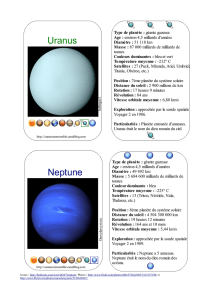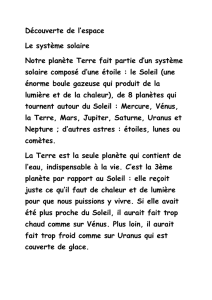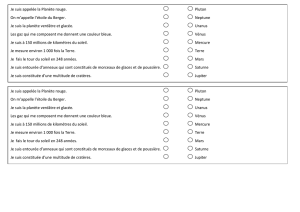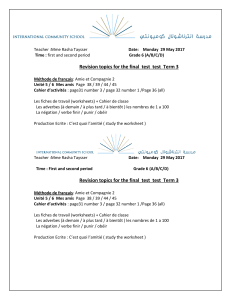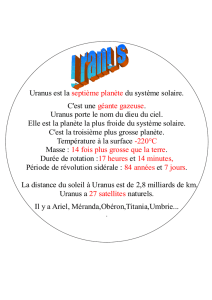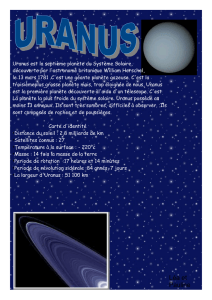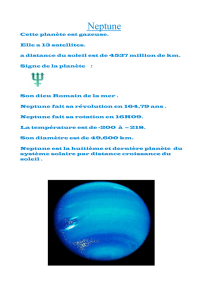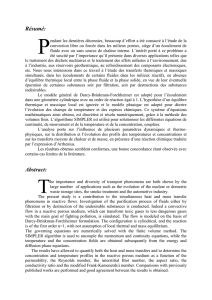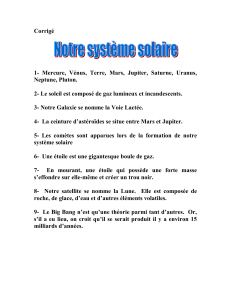Corrections 2016 (Anglais)
publicité
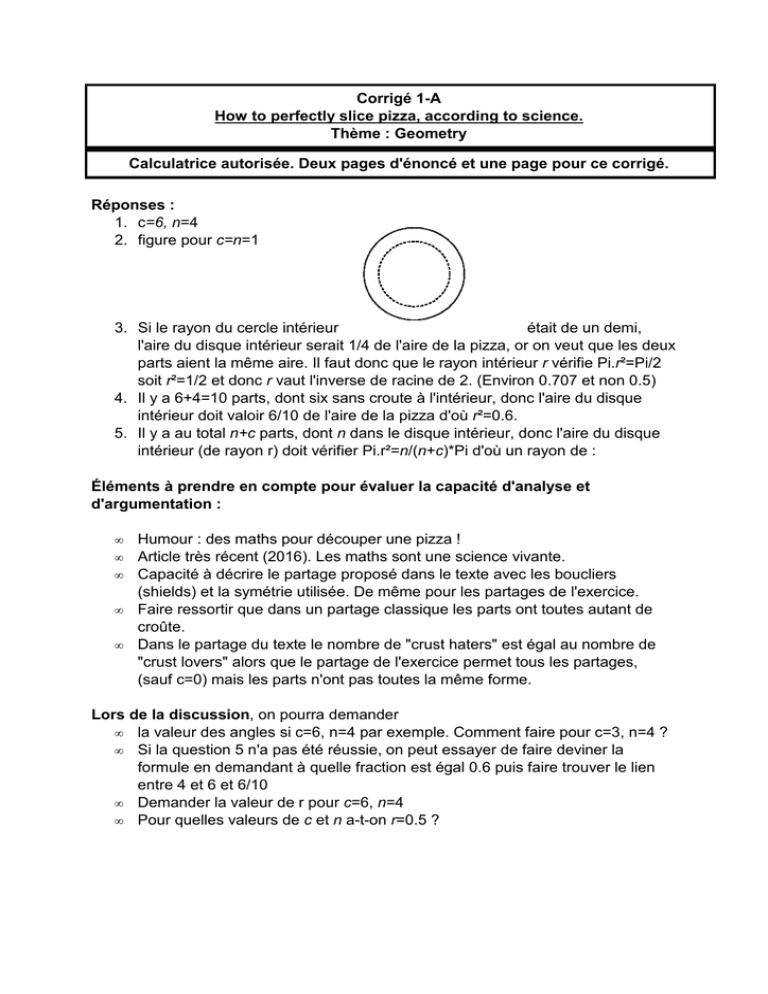
Corrigé 1-A How to perfectly slice pizza, according to science. Thème : Geometry Calculatrice autorisée. Deux pages d'énoncé et une page pour ce corrigé. Réponses : 1. c=6, n=4 2. figure pour c=n=1 3. Si le rayon du cercle intérieur était de un demi, l'aire du disque intérieur serait 1/4 de l'aire de la pizza, or on veut que les deux parts aient la même aire. Il faut donc que le rayon intérieur r vérifie Pi.r²=Pi/2 soit r²=1/2 et donc r vaut l'inverse de racine de 2. (Environ 0.707 et non 0.5) 4. Il y a 6+4=10 parts, dont six sans croute à l'intérieur, donc l'aire du disque intérieur doit valoir 6/10 de l'aire de la pizza d'où r²=0.6. 5. Il y a au total n+c parts, dont n dans le disque intérieur, donc l'aire du disque intérieur (de rayon r) doit vérifier Pi.r²=n/(n+c)*Pi d'où un rayon de : Éléments à prendre en compte pour évaluer la capacité d'analyse et d'argumentation : • • • • • Humour : des maths pour découper une pizza ! Article très récent (2016). Les maths sont une science vivante. Capacité à décrire le partage proposé dans le texte avec les boucliers (shields) et la symétrie utilisée. De même pour les partages de l'exercice. Faire ressortir que dans un partage classique les parts ont toutes autant de croûte. Dans le partage du texte le nombre de "crust haters" est égal au nombre de "crust lovers" alors que le partage de l'exercice permet tous les partages, (sauf c=0) mais les parts n'ont pas toutes la même forme. Lors de la discussion, on pourra demander • la valeur des angles si c=6, n=4 par exemple. Comment faire pour c=3, n=4 ? • Si la question 5 n'a pas été réussie, on peut essayer de faire deviner la formule en demandant à quelle fraction est égal 0.6 puis faire trouver le lien entre 4 et 6 et 6/10 • Demander la valeur de r pour c=6, n=4 • Pour quelles valeurs de c et n a-t-on r=0.5 ? BACCALAURÉAT GÉNÉRAL ET TECHNOLOGIQUE ÉPREUVE SPÉCIFIQUE DES SECTIONS EUROPÉENNES MATHÉMATIQUES – ANGLAIS SUJET 2-A Thème : Fonctions Correction Text 1st paragraph: Who is John Forbes Nash. Next paragraphs: What is the Nash equilibrium; how it is used. Extension: Game theory Exercise 1) The functions and are quadratic. The graph of a quadratic function is a Parabola 2) a) The preimage of 43, can be found by solving the quadratic equation: 2 + 1.5 + 17 = 43 This equation is equation is equivalent to 2 + 1.5 − 26 = 0 The discriminant:∆= 210.25 = The solutions are∶ . √ . ; . = √ . The preimage of 43 is 3.25 The quantity of potatoes supplied at 430€ is 3.25 tonnes b) 5 = 35 5 tonnes of potatoes are demanded at 350€ c) The range of the demand function is 10; +∞ ! The range of the supply function is ! ; +∞ 3) The supply function is decreasing on the interval "−∞; − 3⁄8 and is increasing on the interval − 3⁄8 ;+∞ The demand function is decreasing on the interval "−∞; 10" and is increasing on the interval 10;+∞ 4) The equilibrium quantity is given by the equation 2 + 1.5 + 17 = − 20 + 110 ⟺ + 21.5 − 93 = 0 ∆= 834.25; = . √'! . ; = . √'! . The equilibrium quantity is about1.85tonnes The equilibrium price: 497.95€ BACCALAURÉAT GÉNÉRAL ET TECHNOLOGIQUE ÉPREUVE SPÉCIFIQUE DES SECTIONS EUROPÉENNES MATHÉMATIQUES – ANGLAIS SUJET 3-A Thème : Sequences Correction du sujet : 1. An arithmetic sequence goes from one term to the next by always adding (or subtracting) the same value, whereas a geometric sequence goes from one term to the next by multiplying (or dividing) by the same value. 2. It is a geometric sequence as it is an increase in percentage, the common ratio is 1.03 3. Let an be the amount of money for the nth month an+1 = an ×1.03 a2 = 145×1.03=149.35 John will have to pay 149.35 euros the second month 4. an=a1×1.03n-1 a11=145×1.0310= 194.87 John will have to pay 194.87 euros the eleventh month. 5. S11= 145 × = 1857 The total amount that will be paid by John at the end of the 11th month is 1857 euros 6. 2100-1857=243 The twelfth month, John will have to pay 243 euros Barème : 10 points 1) 1 point 2) 0,5 point pour l’explication et 1 point pour la raison 3) 1 point pour la formule et 1 point pour le deuxième terme 4) 1 point pour la formule et 1,5 points pour le onzième terme 5) 2 points 6) 1 point BACCALAUREAT GENERAL ET TECHNOLOGIQUE EPREUVE SPECIFIQUE DES SECTIONS EUROPÉENNES MATHÉMATIQUES – ANGLAIS Corrigé 4-A Thème : Sequences 1. = 1; = 8; = 512 2. Geometric sequence. The common ration is equal to 2. 3. =2 4. = + +⋯+ = = 1.84 ∗ 10 grains Equal to 1.84 ∗ 10 g Equal to 1.84 ∗ 10 tonnes. The world production in 2012 is equal to 736 ∗ 10 tonnes, so it is impossible for the king to fulfil Sissa's offer, the production of rice in Inda in 3000BC is certainly lower than the world production in 2012. Pistes d'exploitation : Demander à l'élève si le résultat lui paraît possible par rapport à la production mondiale de riz en 2014. Mathématiques : Utilisation d'une suite arithmétique à la place d'une suite géométrique, puissances de 10. Histoire : L'inde et le Royaume-Uni. Culture : Conversions avec l' "imperial system". BACCALAURÉAT GÉNÉRAL ET TECHNOLOGIQUE ÉPREUVE SPÉCIFIQUE DES SECTIONS EUROPÉENNES MATHÉMATIQUES – ANGLAIS Corrigé 5-A Thème : Sequences Le candidat peut commenter les différents modes de paiement au cours du temps et donner son opinion sur les avantages et inconvénients de chacun d'eux, ou les comparer …Il peut parler des modes de payements actuels, carte bleues, paypal, ou autres E card, voire les bitcoins. Il peut enfin parler des placements financiers et des différents types d'intérêts (cumulés ou non) 1. 19 000 * 1,045 – 810 = 19 855 – 810 = 19 045 1 € = 0,76 ₤ 19 045 ₤ after one year 1 ₤ = 1 / 0,76 € and 19 045 ₤ = 19 045 / 0,76 € = 25 059 € 2.a. Increasing by 4,5 % equals multiplying by 1,045. The amount with the interest is 1,045 Cn. The man withdraws 810 pounds; the new amount is 1,045 Cn – 810 b. C1 = 19 045 C2 = 19 092 C3 = 19 141 c. U0 = 1 000 U1 = 1 045 U2 = 1 092 d. (Un) is not arithmetic because there is no common difference. U1 / U0 = 1,045 and U2 / U1 = 1,045. It looks geometric: Common ratio. Proof (not easy ….) [Question bonus pour les TS. (on admet le résultat sinon)] Un+1 = Cn+1 – 1800 = 1,045 Cn – 810 – 18 000 = 1,045( Un + 18 000) – 810 – 18 000 = 1,045 Un + 1,045*18 000 – 810 – 18 000 = 1,045 Un + 18 810 – 810 – 18 000 = 1,045 Un 3. Un = U0 * q n = 1000 * 1,045 n and Cn = Un + 18 000 = 1000 * 1,045 n + 18 000 BACCALAUREAT GENERAL et TECHNOLOGIQUE EPREUVE SPECIFIQUE DES SECTIONS EUROPEENNES DNL- MATHEMATIQUES - ANGLAIS SUJET 6-A Corrigé Thème : Statistics L’usage de la calculatrice est autorisé. Ce sujet comporte deux pages. Part of the history of statistics Questions which can be asked: 1) Do you know some topics in which we use statistics nowadays?(economics, astronomy, medecine,…) 2) Do you know a link between statistics and probabilities? (the law of large numbers) 3) Do you know who Tycho Brahe is? Blaise pascal? Pierre de Fermat? What could you tell about them ?(One is an astronomer who has found accurate results only by his observations of the sky, Pascal and Fermat found a way to solve the problem of points which the solution is the beginning of the theory of probability,the triangle of Pascal is famous and helpful especially to expand expressions) The examiner can also focus on the following questions and issues: 1) Do you have any idea why so many American people own a firearm? 2) This is a quote from Republican presidential candidate Donald Trump about the terrorist attack against the Bataclan: If I had been present at the Paris concert hall when [...] attackers arrived, I would have opened fire on them." What is his opinion? / Can you rephrase what he said? / Do you share his views? 3) If your lover kept holding a gun, how would you react? / Imagine you are going out with someone who keeps holding a gun with him or her all the time. How would you react? Would it be a problem? 1/2 Exercice : 1- In USA : 270/302=0,89 that means 89% In Russia :12.8/147 =0,087 that means 8,7% 2a) The mean = 59, The median = 18 b) Q1= 12,8 Q3= 46 c) d) 25% of the wolrd population owns less than 12.8 millions guns and 50% of the world population has less than 18,000,000 of guns, but USA is one of the country in which the population owns the most guns. 3- 357 /317= 1,1262 e.g. 112,62% 2/2 Proposition de corrigé 7-A Découverte d'Uranus (1781) Contrairement à Mercure, Vénus, Mars, Jupiter et Saturne, Uranus ne fut pas découverte dans l'Antiquité. Étant loin du Soleil et circulant lentement sur son orbite, Uranus fut observée à de nombreuses occasions et apparaissait comme une simple étoile jusqu'au XVIIIe siècle en raison de son très faible éclat, à la limite de la visibilité et de son déplacement apparent très lent. William Herschel annonce sa découverte le 26 avril 1781, élargissant les frontières connues du Système solaire pour la première fois à l’époque moderne. Uranus est la première planète découverte à l’aide d’un télescope. Découverte de Neptune (1846) Neptune n'est pas visible à l'œil nu et, comme Uranus, elle n'a été découverte qu'après l'invention du télescope. Pourtant, cette découverte se démarque de celle des autres planètes : elle a été faite uniquement par le calcul à partir de la trajectoire et des caractéristiques d'Uranus. Le télescope ne servira qu'à la confirmation de la découverte. Déjà en 1788, la planète Uranus récemment découverte, ne semblait pas se conformer au modèle d'orbite que les astronomes avaient prédit. Plus le temps passait et plus l'erreur entre la position annoncée de l'astre et celle relevée augmentait. Étudiant à Cambridge, John Couch Adams tomba le 26 juin 1841 sur le rapport de l'astronome royal Sir George Biddell Airy concernant le problème de l'orbite d'Uranus et fut intéressé par la question. En 1843, Adams se mit au travail. Il termina ses travaux deux ans plus tard en ayant déterminé la position de Neptune avec une erreur de moins de deux degrés. Adams transmit ses résultats à Airy par courrier le 21 octobre 1845, et obtint une réponse le 5 du mois suivant. Airy émit des doutes sur les travaux de son jeune collègue. Découragé par le comportement d'Airy, Adams ne lui répondra qu'un an après. Au même moment en France, François Arago, directeur de l'observatoire de Paris, encourage le mathématicien Urbain Le Verrier, spécialisé en mécanique céleste, à déterminer les caractéristiques de cette huitième planète dont l'influence gravitationnelle se faisait sentir sur la trajectoire d'Uranus. Le Verrier commence ses travaux sur Uranus en 1845, ignorant totalement ceux d'Adams, et publie ses premiers résultats le 10 novembre 1845. Airy, remarquant les travaux de l'astronome français, fait le parallèle avec ceux d'Adams et entre en contact avec Le Verrier. Celui-ci lui demande à son tour d'effectuer les recherches de la planète à l'aide des calculs qu'il vient de publier, mais Airy refuse. Le Verrier communique ses résultats définitifs à l'Académie des sciences le 31 août 1846. Devant le peu d'enthousiasme des astronomes français, il décide de faire alors appel à une de ses connaissances : l'astronome prussien Johann Gottfried Galle de l'observatoire de Berlin. Galle reçoit la position de Neptune par courrier le 23 septembre 1846. Vers minuit, Galle trouve Neptune, à environ un degré de l'emplacement calculé. Outre-Manche, la déception est grande. Une vive polémique s'ensuit jusque dans la presse. Les Britanniques ressortent les papiers d'Adams s'écriant que la découverte leur revient. De leur côté, les Français réfutent en rappelant que seule une publication officielle peut valider la découverte, et refusent de pied ferme que le nom d'Adams figure à côté de celui de Le Verrier dans les livres d'histoire. En juin 1847, Adams et Le Verrier se sont rencontrés pour la première fois à la British Association for the Advancement of Science et ont entretenu par la suite une relation amicale. Neptune est la seule des huit planètes connues à avoir été découverte par le calcul mathématique plutôt que par l'observation empirique. Contrairement aux sept autres planètes, Neptune n'est jamais visible à l'œil nu. Pluton, neuvième planète (1930-2006) ? À la suite de la découverte de la planète Neptune en 1846, de nombreuses spéculations sur l'existence d'une autre planète pouvant exister au-delà de son orbite commencèrent à émerger. La recherche a commencé dans le milieu du XIXe siècle et a culminé au début du XXe avec Percival Lowell. Lowell proposa l'hypothèse de la Planète X pour expliquer des contradictions apparentes dans les orbites des planètes géantes gazeuses, en particulier Uranus et Neptune La découverte de Pluton par Clyde Tombaugh en 1930 semble valider l'hypothèse de Lowell, et Pluton est alors officiellement considérée comme la neuvième planète. En 1978, Pluton a été jugée trop petite pour que sa gravité puisse affecter les géantes de gaz, ce qui entraîne une brève recherche d'une dixième planète. La recherche a été largement abandonnée dans les années 1990, quand une étude des mesures effectuées par le vaisseau spatial Voyager 2 a constaté que les irrégularités constatées dans l'orbite d'Uranus étaient dues à une légère surestimation de la masse de Neptune. Après 1992, la découverte de nombreux petits objets glaciaux avec des orbites semblables ou même plus larges que Pluton a conduit à un débat quant à savoir si Pluton devait rester une planète. En 2006, l'Union astronomique internationale a reclassé Pluton et ses grands voisins comme planètes naines, ne laissant que huit planètes dans le système solaire. Un pas mathématique vers la découverte d'une « vraie » neuvième planète (2016) Le 20 janvier 2016, Konstantin Batygin et Michael E. Brown publient un article dans l'Astronomical Journal où ils évoquent la possible existence d'une planète supplémentaire à grande distance du Soleil. De manière provisoire et officieuse, ils la baptisent "Phattie". Cet article a par ailleurs été relu par Alessandro Morbidelli, astronome dynamicien de l'Observatoire de Nice. L'étude ayant abouti à cet article repart du constat, déjà évoqué par Trujillo et Brown en 2014, de l'orientation semblable de l'orbite de plusieurs objets transneptuniens : leurs périhélies ont des arguments (position angulaire par rapport au Soleil) proches. Selon cet article, il n'existe que 0,007 % de probabilité que ce regroupement soit dû au hasard. "Phattie", la planète annoncée, également appelée la planète Neuf (« Planet Nine » en version originale ; d'après son numéro d'ordre en termes de distance au Soleil) par les auteurs, serait située entre 300 et 600 unités astronomiques du Soleil, ne s'en approcherait jamais à moins de 200 unités astronomiques, et aurait une période orbitale de quinze à vingt mille ans. Elle aurait une masse de quelques fois celle de la Terre et serait donc une super-Terre ou une planète comparable à Neptune. Source : wikipedia Proposition de corrigé Exercise : 1) 28 75 75 200 G M 47 75 G 2 125 125 200 G M 123 125 p ( M )= 75 =0,375 200 p ( M )= 125 =0,625 200 p (G )= p ( M )× p M (G )+ p( M )× p M (G )= p M (G )= 2) 28 ≈0,37 75 G p M (G)= 28 2 + =0,15 200 200 2 ≈0,016 125 et p(G∩M ) 0,14 p G (M )= = ≈0,93 p(G ) 0,15 3) p ( M )= 75 =0,375 200 p G (M )= 4) is to be compared to Strong point: it makes a big difference Weak point: detecting extrasolar planets is not so easy Weak point : detecting extrasolar planets is not so easy. p(G∩M ) 0,14 = ≈0,93 p(G ) 0,15 . BACCALAURÉAT GÉNÉRAL ET TECHNOLOGIQUE ÉPREUVE SPÉCIFIQUE DES SECTIONS EUROPÉENNES MATHÉMATIQUES – ANGLAIS Corrigé 8-A Thème : Probabilités The Monty Hall problem 1°) Habituellement les personnes interrogées pensent que l'information donnée par l'animateur ne change rien à leur choix initial puisqu'elle ne concerne pas directement leur choix initial. Or en changeant de porte après ouverture de l'une des portes cachant une chèvre, la probabilité de gagner passe de 1/3 à 2/3. C'est ce que montre la suite du problème. 2°) a) Si on ne tient aucun compte de l'information, la probabilité de choisir la voiture est p=1/3. b) Si on choisit au hasard entre deux portes, on a une chance sur deux de gagner la voiture : p=0,5 3°) a) La troisième stratégie consiste à systématiquement changer de porte après avoir reçu l'information de l'animateur. b) Si la première porte cachait une chèvre alors la porte restante cache assurément la voiture. Si on change de porte sachant qu'on avait précédemment une chèvre, on est gagnant à coup sûr. c) La probabilité d'avoir initialement une chèvre est de 2/3. d) Si on adopte la stratégie consistant à changer de porte, il y a deux cas : - Le choix initial était la voiture : on est alors perdant à coup sûr. - Le choix initial était une chèvre : on est alors gagnant à coup sûr (comme dit au 3.b ). La probabilité de gagner la voiture si on change de porte est donc égale à la probabilité d'avoir initialement choisi une chèvre : 2/3. La stratégie qui offre la meilleure probabilité de gagner est donc le changement systématique de porte après avoir reçu l'information. Une ouverture possible est de demander à l'élève de modéliser à l'aide d'arbres de probabilité la situation correspondant à chacune des stratégies. On vérifie alors par le calcul que la dernière stratégie est la meilleure. On peut rajouter une question 4) ou orienter l'entretien vers des probabilités conditionnelles. Soit : 4°) Using tree diagrams, describe the three strategies and their winning probability. BACCALAUREAT GENERAL ET TECHNOLOGIQUE EPREUVE SPECIFIQUE DES SECTIONS EUROPEENNES MATHEMATIQUES - ANGLAIS SUJET 11-A : Eléments de correction Fractals and Koch snowflake Theme: Geometry and sequences Exercise 1. First, we divide the side into three equal parts. Then, we draw an equilateral triangle, the base of which is the middle part of the side. Finally, we erase this part. 2. Complete the following table: Iteration, 1 2 3 Number of sides, 3 12 48 Length of a side, 1 3. a. At each iteration, we multiply the number of sides by4 and the length of a side by . So the sequences follow arithmetic progressions. b. 3 4 3 4 and 4. a. b. 3 . c. The perimeter of the Koch snowflakes follows a geometric progression, and its common ratio is , which is greater than1, so the limit of the perimeter is infinity. 1/1 BACCALAURÉAT GÉNÉRAL ET TECHNOLOGIQUE ÉPREUVE SPÉCIFIQUE DES SECTIONS EUROPÉENNES MATHÉMATIQUES – ANGLAIS Corrigé 12-A Thème : Numbers 1. a. b. a and b ≠ 0 b 2 −1 ; 3 5 2. a. an irrational number is a number that cannot be written. b. π ; e ; ln 2 ; 2 3. a. 4 13 4 × 3 13 + = + 5 15 5 × 3 15 25 = 15 5 = 3 = 1+ 2 3 = 1+ b. 2 ( mixed number ) 3 a c ad + bc + = b d bd 4. True… (démonstration par l’absurde, aucune exigence) 5. π + (2 − π ) = 2 ... CORRIGÉ 13-A Odd arguments Reasoning about parity Texte du corrigé a. An even number is an integer divisible by two with no remainder. In other words, even numbers are the multiples of two. An odd number is an integer not exactly divisible by two. In other words, an odd number is a multiple of two plus one. 0 is even because 0 = 2 × 0 An even number is an integer that ends in 0, 2, 4, 6 or 8. Let a and b be odd integers, we can write: a = 2m + 1 and b = 2n + 1 . So a + b = ( 2m + 1) + ( 2n + 1) = 2 ( m + n + 1) . So a + b is an even number. If c is odd as well, c = 2 p + 1 so a + b + c = 2 ( m + n + 1) + 2 p + 1 = 2 ( m + n + p + 1) + 1 . So, the sum of three odd numbers is always an odd number. Let a be an odd integer, we can write: a = 2m + 1 . So a 2 = ( 2m + 1)2 = 4m 2 + 2m + 1 = 2 ( 2m2 + m ) + 1 . b. c. d. e. It means that the square of an odd number is always odd. 10 × (1 + 10 ) 1 + 2 + 3 + 4 + 5 + 6 + 7 + 8 + 9 + 10 = = 55 . It’s an odd number. f. 2 (Actually, we can notice that this sum is an odd number without computing it) Let’s denote S the sum of the numbers we will change into their opposite numbers . The new sum will be: 55 − 2S . This number is odd, so it can’t be 0. Éléments à prendre en compte pour évaluer la capacité d'analyse et d'argumentation : • The pun in the title about the double meaning of « odd » • • It would be a good idea to comment on the special status of “0” in math. Why so many mistakes are made using this number even by educated people? Correct usage of the vocabulary about integers. • Ability to use the “trial and error” strategy in the last question. BACCALAURÉAT GÉNÉRAL ET TECHNOLOGIQUE ÉPREUVE SPÉCIFIQUE DES SECTIONS EUROPÉENNES MATHÉMATIQUES – ANGLAIS CORRIGÉ SUJET 15-A 2. The candidate is expected to use the picture given in the text of the different triangles. The different points expected are: • • • • • The first triangular number is 1 To find the next triangular number we add a line to the existing triangle This line has a length of 1 more than the longest line in the existing triangle In fact the nth line in the triangle has a length of n So the nth triangular number is the sum of the first n positive integers. Exercises : 1. Let n be an integer greater than or equal to 1. +1 −1 − = − 2 2 So, = + ; Tn +1 = Tn + n + 1 2. 2016 = ↔ 4032 = + ↔ + = 2 = 2 − 4032 = 0 Calculating the discriminant gives ∆= 16129 and so there are two solutions: = 63and = −64 As n needs to be a positive integer we can ignore the second solution and thus 2016 is the 63rd triangular number. 3. The number of distinct handshakes is the triangular number 190. = = BACCALAURÉAT GÉNÉRAL ET TECHNOLOGIQUE ÉPREUVE SPÉCIFIQUE DES SECTIONS EUROPÉENNES MATHÉMATIQUES – ANGLAIS SUJET 16-A Thème : Conditional probabilities Corrigé COMMENTAIRE DU TEXTE : On attend du candidat qu’il explique que ce texte issu d’un article récent sur les comportements humains relève de quoi dépend l’espérance de vie d’un être humain, vocabulaire qu’il sera bon de définir par ailleurs. On peut espérer que le candidat donne des exemples de comportements ou de pathologies susceptibles de faire varier cette espérance (en moins ou en plus : cancer, habitudes alimentaires, sport …), qu’il explique en quoi consiste un panel représentatif et ce qui détermine sa constitution. Ensuite le candidat pourra expliquer la notion de probabilité conditionnelle mathématique puisque ce vocabulaire est évoqué par l’auteur de l’article. EXERCISE Part A Let’s call E the event « the man lives at least 80 years » and S the event « the man lives at least 70 years ». We are looking for the conditional probability P(E / S) = P(E and S)/P(S) The denominator is known: P (S) = 0.8 As far as the numerator is concerned, note that S is part of E (if you live at least 80 years then you also live at least 70 years). So this implies that E and S = E Therefore, P (E and S) = P(E) = 0.5. Thus, P (E/S) = 0.5/0.8 = 5/8 = 0.625 So the probability that a man lives at least 80 years given that he has just celebrated his 70th birthday is 62.5% Part B Let’s build a probability tree to sum up the situation: S 0.25 H 0.5 S’ A S 0.5 0.046 H’ S’ Where A is a person who has a cardiovascular accident, H the event « in front of a witness who knows how to save people », H’ its complement, S the event « the person survives », S’ its complement. P (S) = 0.5*0.25 + 0.5*0.046 = 0.148 To know the number of surviving people, we multiply 55,000 by this probability so we find 55,000*0.148 = 8140 people. Finally, subtracting from this number the 1,650 people who are saved anyway, we find 6,490 which is the number of lives which could be saved if those conditions were filled! Let’s quickly learn how to accomplish healthcare routine!!! Corrigé 17-A : Pythagorean Theorem Geometry Éléments à prendre en compte pour évaluer la capacité d'analyse et d'argumentation : • Toute information sur Pythagore • Toute connaissance sur les démonstrations sans les mots • Éventuellement une explication sur le cas particulier où les deux plus petits côtés sont égaux. 1. Pythagoras' Theorem asserts that for a right-angled triangle, the area of the square on the hypotenuse (the longest side) is the sum of the areas of the squares on the smaller sides. 2. 3. We can reassemble the five parts obtained by the smaller squares to make up the largest square. 4. The ladder is the hypotenuse of a right-angled triangle. According to the Pythagorean theorem: Substitute Multiply Subtract from both sides Take the square root of each side The top of the ladder will touch the wall about 19.4 feet up from the ground. BACCALAURÉAT GENERAL ET TECHNOLOGIQUE ÉPREUVE SPÉCIFIQUE DES SECTIONS EUROPÉENNES MATHÉMATIQUES - ANGLAIS Corrigé 18-A : Magic and mathematics Theme : Arithmetic and probabilities L’usage de la calculatrice est autorisé. Ce corrigé comporte une page. Exercise 1. a. The number you will get at the end of your calculations is 3,766. b. The number you will get at the end of your calculations is 2,853. 2. a. To find the numbers on your first and third die, you subtract one to the 1st and 3rd digits of your result. For the second and fourth one, you keep your result. So the numbers on the dice were 8(9 – 1) ; 2 ; 6(7 – 1) and 4. If you check : b. Let be the number on the first die Let be the number on the third die ; Let ; Let be the number on the second die be the number on the fourth die. . If you subtract one to the thousands’ digit and subtract one to the tens’ digit in your final result, then: The thousands’ digit will be the number on your first die. The hundreds’ digit will be the number on your second die. The tens’ digit will be the number on your third die. The units’ digit will be the number on your fourth die. 3. To get 7,536, you must have : 6 on your first die, 5 on the second one, 2 on the third one and 6 on the last one. The probability to get a 6 on the 1st die is . The probability to get a 5 on the 2nd die is . The probability to get a 2 on the 3rd die is . The probability to get a 6 on the 4th die is . Finally, the probability to get the answer 7,536 is That’s to say approximately . , which is approximately . BACCALAURÉAT GÉNÉRAL ET TECHNOLOGIQUE ÉPREUVE SPÉCIFIQUE DES SECTIONS EUROPÉENNES MATHÉMATIQUES – ANGLAIS SUJET 19-A Thème : Probability Correction a) 95% of students at school are between 1.1m and 1.7m tall. Assuming this data is normally distributed can you calculate the mean and standard deviation? The mean is halfway between 1.1m and 1.7m: Mean = (1.1m + 1.7m) / 2 = 1.4 m 95% is 2 standard deviations either side of the mean (a total of 4 standard deviations) so: = (1.7m − 1.1m)/4 = 0.15 m b) Your score in a recent test was 1 standard deviation above the average, how many people scored lower than you did? Between 0 and 1standard deviation is 34%; Less than 0 is 50% (left half of the curve) So the total less than you is: 50% + 34% = 84% In theory 84% scored less than you did (but with real data the percentage may be different) c) The mean June midday temperature in DesertTown is 36°C and the standard deviation is 3°C. Assuming this data is normally distributed, how many days in June would you expect the midday temperature to be between 39°C and 42°C? 39°C is one standard deviation above the mean and 42°C is two standard deviations above the mean: Therefore we would expect the temperature to be between 39°C and 42°C on 13.5% of the days (95 – 68 ) /2 = 13. 5% There are 30 days in June 13.5% * 30 = 4.05 ≈ 4 to the nearest day d) In a population that is normally distributed with mean 96 and standard deviation 25. The bottom 84 % of the values are those less than ?……………121 84 = 50 + 34; + = 96 + 25 = e) The Fresha Tea Company pack tea in bags marked as 250g. A large number of packs of tea were weighed and the mean and standard deviation were calculated as 255 g and 2.5 g respectively. Assuming this data is normally distributed, what percentage of packs are underweight? 250 = 255 − 2 × 2.5 = − 2 250 g is 2 standard deviations below the mean. 2.5% of packs were underweight.
